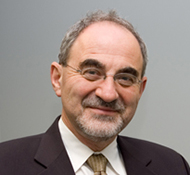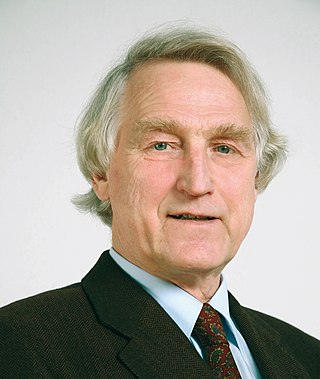Related Research Articles

Eli Yablonovitch is an American physicist and engineer who, along with Sajeev John, founded the field of photonic crystals in 1987. He and his team were the first to create a 3-dimensional structure that exhibited a full photonic bandgap, which has been named Yablonovite. In addition to pioneering photonic crystals, he was the first to recognize that a strained quantum-well laser has a significantly reduced threshold current compared to its unstrained counterpart. This is now employed in the majority of semiconductor lasers fabricated throughout the world. His seminal paper reporting inhibited spontaneous emission in photonic crystals is among the most highly cited papers in physics and engineering.
In the 19th century, it was observed that the sunlight striking certain materials generates detectable electric current – the photoelectric effect. This discovery laid the foundation for solar cells. Solar cells have gone on to be used in many applications. They have historically been used in situations where electrical power from the grid was unavailable.

A solar cell, or photovoltaic cell, is an electronic device that converts the energy of light directly into electricity by the photovoltaic effect, which is a physical phenomenon. It is a form of photoelectric cell, defined as a device whose electrical characteristics, such as current, voltage, or resistance, vary when exposed to light. Individual solar cell devices are often the electrical building blocks of photovoltaic modules, known colloquially as solar panels. The common single-junction silicon solar cell can produce a maximum open-circuit voltage of approximately 0.5 to 0.6 volts.

Martin Andrew Green is an Australian engineer and professor at the University of New South Wales who works on solar energy. He was awarded the 2021 Japan Prize for his achievements in the "Development of High-Efficiency Silicon Photovoltaic Devices". He is editor-in-chief of the academic journal Progress in Photovoltaics.
I.M. Dharmadasa is Professor of Applied Physics and leads the Electronic Materials and Solar Energy Group at Sheffield Hallam University, UK. Dharme has worked in semiconductor research since becoming a PhD student at Durham University as a Commonwealth Scholar in 1977, under the supervision of the late Sir Gareth Roberts. His interest in the electrodeposition of thin film solar cells grew when he joined the Apollo Project at BP Solar in 1988. He continued this area of research on joining Sheffield Hallam University in 1990.
Allen M. Barnett was a research professor of electrical engineering at the University of Delaware. He was the principal investigator of the DARPA-funded Consortium for Very High Efficiency Solar cells. Barnett was the founder and CEO of solar-cell producer Astropower, Inc. He was also a Professor of Advanced Photovoltaics at the University of New South Wales (UNSW) School of Photovoltaic and Renewable Energy Engineering (SPREE) in Sydney Australia.
Andrew Blakers is a Professor of renewable energy engineering at the Australian National University. He has contributed to several innovations in solar photovoltaic technology, including PERC solar cells. Blakers has secured many research grants and won several awards.

Joachim Luther received his PhD in experimental physics at the Leibniz University Hannover in 1970.

Between 1992 and 2022, the worldwide usage of photovoltaics (PV) increased exponentially. During this period, it evolved from a niche market of small-scale applications to a mainstream electricity source. From 2016-2022 it has seen an annual capacity and production growth rate of around 26%- doubling approximately every three years.

Crystalline silicon or (c-Si) Is the crystalline forms of silicon, either polycrystalline silicon, or monocrystalline silicon. Crystalline silicon is the dominant semiconducting material used in photovoltaic technology for the production of solar cells. These cells are assembled into solar panels as part of a photovoltaic system to generate solar power from sunlight.
Larry C. Olsen was a pioneer in the commercialization of betavoltaic technology. While working for the McDonnell Douglas Corporation in the 1970s, Olsen lead the development of the first commercially available betavoltaic nuclear battery. Several hundred of these batteries were fabricated and a large number were used to power implanted heart pacemakers. Olsen has published more than 80 articles in the fields of betavoltaics, photovoltaics, thermoelectric materials, and solid state physics. He has also earned several awards for his research, including the R&D 100 Award, presented each year by R&D Magazine to identify the 100 most significant, newly introduced research and development advances in multiple disciplines.

Antonio Luque López is a Spanish scientist and entrepreneur in the field of photovoltaic solar energy. In 1979 he founded the Institute of Solar Energy of the Technical University of Madrid (IES-UPM) and was its director till his retirement in 2017; he is currently its honorary president as well as professor emeritus in this university. He invented the bifacial solar cell in the late 1970s, today one of the mainstream solar cell technologies, and founded Isofoton in 1981 for its industrial production. He is, arguably, one of the fathers of the science and technology of concentrator photovoltaics and has been active in the research and development of high-efficiency photovoltaic conversion devices, inventing the intermediate band solar cell.

Jenny Nelson is Professor of Physics in the Blackett Laboratory and Head of the Climate change mitigation team at the Grantham Institute - Climate Change and Environment at Imperial College London.

Henry James Snaith is a professor in physics in the Clarendon Laboratory at the University of Oxford. Research from his group has led to the creation of a new research field, based on halide perovskites for use as solar absorbers. Many individuals who were PhD students and postdoctoral researchers in Snaith's group have now established research groups, independent research portfolios and commercial enterprises. He co-founded Oxford Photovoltaics in 2010 to commercialise perovskite based tandem solar cells.

Vinay Gupta is an Indian materials scientist and a former senior scientist at the Physics of Energy Harvesting department of the National Physical Laboratory of India. Known for his studies on organic solar cells, carbon nanotubes arrays and Förster resonance energy transfer, Gupta is a former Alexander von Humboldt Fellow. The Council of Scientific and Industrial Research, the apex agency of the Government of India for scientific research, awarded him the Shanti Swarup Bhatnagar Prize for Science and Technology, one of the highest Indian science awards, for his contributions to physical sciences in 2017.

Uwe Rau is a German physicist who made important contributions to the physics of the photovoltaic device, notably on explaining energy losses in thin-film solar cells and on the use of the reciprocity principle to characterize solar cells by electroluminescence techniques. This led to the development of this technique as a standard in research and industry.
Oxford Photovoltaics Limited is an Oxford University spin-off company in the field of perovskite photovoltaics and solar cells.
Sarah R. Kurtz is an American materials scientist known for her research on solar energy and photovoltaics, including the application of multi-junction solar cells in robotic spacecraft. Formerly a research fellow at the National Center for Photovoltaics and principal scientist at the National Renewable Energy Laboratory, she is a professor of materials science and engineering at the University of California, Merced.
Joseph Appelbaum is a professor (emeritus) in the Engineering Faculty at Tel Aviv University, and former holder of the Ludwig Jokel Chair of Electronics in the faculty. He is a life fellow of IEEE “for contributions to solar conversion systems”.
David E. Carlson was an American physicist who invented thin film, amorphous silicon based, photovoltaic solar cells.
References
- ↑ "Up close with Professor Armin Aberle". EcoGeneration. Melbourne: Great Southern Press (61): 92. November 2010.
- 1 2 "Armin Aberle". IEEE Electron Devices Society. IEEE. Archived from the original on 14 July 2014. Retrieved 9 July 2014.